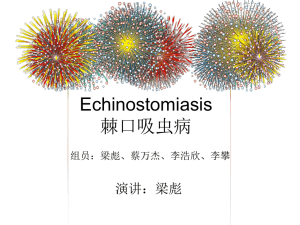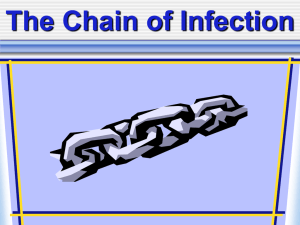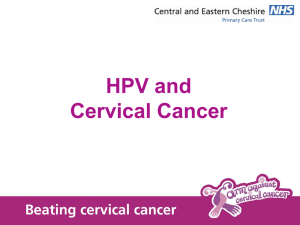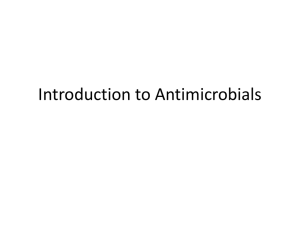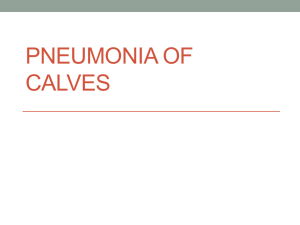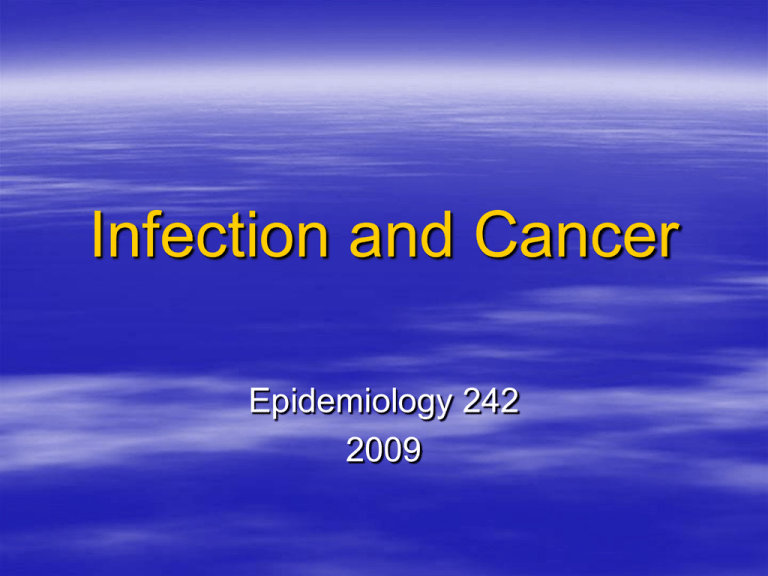
Infection and Cancer
Epidemiology 242
2009
Major Infection-Associated
Malignancies
In 2002, 17.8% of the global cancer burden (1.9 million
cases) were infection-attributable
Malignancy (infection)
Stomach cancer (Helicobactor pylori)
Cervical cancer (human papillomavirus)
Liver cancer (hepatitis B and C viruses)
Burkitt’s lymphoma and nasopharyngeal cancer (EpsteinBarr virus)
Kaposi sarcoma and Non-Hodgkin lymphoma (HIV/HHV-8)
Bladder and colon cancer (schistosomiasis)
Adult T-cell leukemia/lymphoma (human T-cell
lymphotropic virus type I)
Mechanisms of Infection-Induced
Malignancy
Chronic Inflammation and Carcinogenesis
Chronic host-pathogen interaction
Immunosuppression
Chronic inflammation
Oxidative Stress
DNA damage and mutations
Cell injury
Cell division
Infection inducing Cell proliferation
Production of Oncogenic Proteins
Genomic Instability from Viral Genomic Integration
H. pylori Infection and
Stomach Cancer
Helicobacter pylori
Helicobacter pylori was the first bacterium to be officially
recognized as a cancer-causing agent
Flagellated gram-negative, spiral-shaped rod bacterium
Chronically infects 50% of the worldwide population
– In developing countries, infection is universal among adults and
about half of children <10 years are infected
– In developed countries, 40-50% of adults are infected and infection
among children is unusual
Roughly 1% of those infected eventually develop stomach
cancer
Infection is inversely correlated with socioeconomic status
(from household crowding, less household sanitation and
hygiene)
Nitrates and nitrites are substances commonly found in
cured meats, some drinking water, and certain vegetables,
that can be converted by H. pylori into compounds that
have been found to cause stomach cancer in animals
5.5% of ALL cancers attributed to H. pylori
World prevalence of H. pylori
infection in adults
Source: Parkin, 2006
Stomach cancers attributable
to H. pylori infection (2002)
Source: Parkin, 2006
H. pylori and gastric cancer - Prospective studies: metaanalysis of non-cardia cancer cases.
H. pylori and gastric cancer - Prospective studies: metaanalysis of cardia cancer cases.
H. pylori Infection and Stomach Cancer
in Whites at MSKCC
H. Pylori
no
yes
case/control
69/54
67/15
Infection rates:
21.7% in controls
49.3% in cases
OR
1.00
3.50 (1.80-6.79)
Biomarker in Epidemiology:
Biomarkers of Biological Agents
Biological agents associated with chronic infection
and subsequent development of cancer are
measured using serological or nucleic acid
markers
VacA expression and “pathogenicity island”
increase inflammation and damage
Anitbodies to CagA, an island protein, can be
detected in serum and used to indicate more
inflammatory strains
HPV and Cervical Cancer
Human Papillomavirus
Nonenveloped DNA virus
More than 70 different types
Infects the squamous epithelium of the genital
tract, skin, and upper respiratory tract
Most infections are transient
Infection of the genital tract highly prevalent
worldwide
– Higher prevalence in younger women than older (In US,
30-40% in young women visiting university health clinics
vs. 17% in older women visiting HMO clinics)
High-risk HPV detected in 90-95% of cervical
cancers
Mechanism of carcinogenesis: oncogenic proteins
(E6 and E7)
5.2% of ALL cancers attributed to HPV
Cancers attributable to HPV
infection (2002)
Source: Parkin, 2006
Map of the HPV-16 genome
Mechanism of Carcinogenesis
HPV DNA integrates into host genome.
Often, E2/E1 gets disrupted during integration and
no longer regulates E6/E7 proteins.
E6/E7 expression increases.
E6 interacts with p53 and promotes the
degradation of p53.
E7 interacts with pRB and releases E2F which
promotes cell cycle progression.
E7 interacts with p21 and inhibits it so that it
cannot inhibit cyclin dependent kinase.
HPV Testing and Typing
HPV infection is the main cause of cervical
cancer.
Only 10-20% persistent infections are at risk
of neoplasia.
About 70 subtypes, of which 25 are tropic
for genital tract. Those are subdivided into
three categories:
HPV Testing and Typing
Low-risk: HPV 6, 11, 40s, strongly
associated with LGSIL, rarely associated
with HGSIL, never associated with cancer
Intermediate-risk: HPV 31, 33, 35, 51, 52,
strongly associated with HGSIL
High-risk: HPV 16, 18, 45, 56, strongly
associated with HGSIL and cancer
Biomarker in Epidemiology:
Biomarkers of Biological Agents
HPV DNA by PCR-based assays
HPV infection is often transient, especially in
young women so that repeated sampling is
required to assess persistent HPV infections
HPV Testing and Typing
HPV can be tested and typed by dot blot
hybridization, southern blot hybridization,
Hybrid Capture and PCR
High sensitivity but relatively low specificity,
particular among young women
HPV typing has great potential as a primary
screening tool for cervical cancer.
Classification of Cervical Squamous Neoplasia
Dysplasia
PapS.
CIN scale
Bethesda
Normal
Infla. Atypia
Koilocyt.Atypia
1
2a
2b
Normal
Infla. atypia
Koilocyto a.
Normal
Normal
LG SIL
Mild dysplasia
Moderate dysp.
Severe dysp.
3
3
3
CIN1
CIN2
CIN3
LG SIL
HG SIL
HG SIL
Ca. in situ
Invasive ca.
4
5
CIN3
Invasive ca
HG SIL
Invasive ca
HBV and Liver Cancer
Hepatitis B Virus
Enveloped DNA virus
350 million people chronically infected worldwide
Prevalence of chronic infection in high-prevalence areas
can be as high as 10-15%
About 80% of liver cancers worldwide are in HBV-infected
individuals
Those chronically infected have a 40% lifetime risk of
developing HCC
Major pathways by which HBV infection increases risk for
liver cancer are:
(1) chronic inflammation (necroinflammatory liver
disease)
(2) oncogenic proteins (X protein)
(3) genomic instability from viral DNA integration
3.1% of ALL cancers attributed to HBV (4.9% to HBV and
HCV)
Prevalence of chronic infection by
HBV (HBsAg) and HCV (anti-HCV)
Liver cancers attributable to
HBV or HCV
**85% of liver cancers attributable to HBV or HCV
Source: Parkin, 2006
Cancer in cirrhotic liver
Up to 90% of HCC have co-existing cirrhosis
Taixing City, PRC Population-Based Case-Control Study:
The relationship between liver cirrhosis and liver cancer
Liver cirrhosis
Case
N
No
Yes
Control
N
%
%
149(86.6)
23 (13.4)
Crude OR
(95%CI)
Adjusted OR
(95% CI)
18.3(5.40~61.8)
22.1(6.11~79.9)
355(99.2)
3
(0.8)
Biomarker in Epidemiology:
Biomarkers of Biological Agents
HBV infection by serological assays.
There are serological markers that
distinguish between past and persistent
infections. HBV DNA detection in sera
further refines the assessment of exposure.
Self-reported hepatitis virus infection type
Hepatitis
History
No
Case
N
%
108(60.34)
Control
N
%
Crude OR
(95%CI)
Adjusted OR
(95% CI)
354(90.08)
1
1
HAV
16(8.94)
19(4.84)
2.77(1.38~5.57)
2.67(1.27~5.60)
HBV
55(30.73)
19(4.40)
11.30(6.22~20.5)
14.52(7.38~28.6)
HDV
0 (0)
1(0.26)
Relationship between HBV vaccine and liver cancer
HBV vaccine
Case
N
No
Yes
%
157(96.32)
6(3.68)
Control
N
%
293(86.14)
47(13.9)
Crude OR
(95%CI)
1
0.24(0.10~0.57)
Adjusted OR
(95% CI)
1
0.24(0.10~0.60)
Effects of HBsAg and anti-HCV on HCC development
Variables
HBsAg
HCV
Case
Control
Crude
Age & Sex
Adjusted
N (%)
N (%)
OR (95%CI)
OR (95%CI)
OR (95%CI)
Fully Adjusted**
-
72
(35.3)
312
(75.4)
1
1
1
+
132
(64.7)
102
(24.6)
5.61 (3.90-8.07)
5.21 (3.60-7.53)
5.68 (3.80-8.51)
-
183
(91.0)
403
(97.1)
1
1
1
+
18
(9.0)
12
(2.9)
3.30 (1.56-7.00)
3.66 (1.70-7.89)
4.19 (1.72-10.22)
**Model includes age, sex, BMI, education, alcohol consumption, tobacco smoking, HBsAg, imputed AFB1
levels, anti-HCV
Most frequent HBV infection spectrum in cases and controls
HBsAg
HBsAb
HBeAg
HBeAb
HBcAb
Crude OR
(95%CI)
Adjusteda
(95%CI)
2
-
-
-
-
-
1.00
1.00
1
-
+
-
-
-
0.24 (0.09~0.63)*
0.23 (0.09~0.61)*
3
-
+
-
-
+
1.00 (0.49~2.03)
1.02 (0.49~2.11)
1
+
+
-
+
+
4.74 (2.48~9.06)*
3.91 (1.99~7.66)*
2
+
+
-
-
+
8.9 (4.00~19.73)*
7.68 (3.23~18.31)*
3
+
+
+
-
+
12.50 (4.78~32.73)*
TYPE
11.55 (4.18~31.90)*
Interaction between HBsAg and anti-HCV
Anti-HCV
HBsAg
Case
N (%)
Control
Crude OR
(95% CI)
Adjusted
OR (95%CI)
N (%)
No
Negative
63(31.19)
304(73.08)
1
1
Yes
Negative
6(2.97)
10(2.40)
2.90(1.02~8.26)
2.63(0.88~7.85)
No
Positive
120(59.41)
100(24.04)
5.79(3.96~8.46)
5.20(3.49~7.76)
Yes
Positive
13(6.44)
2(0.48)
31.37(6.91~ 42.44)
23.99(5.09~ 13.12)
Interaction between HBV and IFNA17
HBsAg
Case
N (%)
Control
Crude
Fully Adjusted**
N (%)
OR (95%CI)
OR (95%CI)
IFNA17
II
-
13
(6.8)
66
(17.3)
1
1
RI&RR
-
50
(26.3)
220
(57.6)
1.15 (0.59-2.25)
1.34 (0.64-2.82)
II
+
20
(10.5)
27
(7.1)
3.76 (1.64-8.62)
3.99 (1.54-10.32)
RI&RR
+
107
(56.3)
69
(18.1)
7.87 (4.04-15.34)
9.18 (4.34-19.43)
ORint (95%CI)=
1.81 (0.71-4.62)
1.71 (0.60-4.92)
IFNA17
-
1.15 (0.59-2.25)
1.35 (0.63-2.85)
(RI&RR vs. II)
+
2.09 (1.09-4.02)
2.19 (1.01-4.76)
**Model includes age, sex, BMI, education, alcohol consumption, tobacco smoking, imputed AFB1
levels, anti-HCV
EBV and Cancer
Epstein-Barr Virus
Enveloped DNA virus
Infects >90% of the population worldwide
Transmitted by salivary exchange
Infects both epithelial and B cells
Associated with Burkitt’s lymphoma,
Nasopharyngeal cancer (NPC), and lymphomas in
immunocompromised patients
Mechanism of carcinogenesis: latent membrane
protein 1 (LMP1) located in host cell membrane
– Lymphocytes: Inhibits apoptosis
– Epithelial cells: Activates expression of (1) epidermal
growth factor receptor and (2) antiapoptotic factor A20
Cancers attributable to EBV
**82% of Burkitt Lymphoma, 46% of Hodgkin Lymphoma, and 98% of
NPC are attributable to EBV
Source: Parkin, 2006
HIV and Cancer
HIV and Cancer
HIV strongly linked with Kaposi Sarcoma
and Non-Hodgkin lymphoma
KS: HIV’s immunosuppression allows
human herpes virus 8 (HHV-8) to replicate
uncontrolled and increase viral load
However the incidence of non-AIDS-defining
cancers (NADCs like lung, anal, cervical
cancer) is increasing among those HIVinfected due to potent antiretroviral
therapies
Cancers attributable to HIV or
Human Herpes Virus 8 (HHV-8)
**All cases of KS and 12% of NHL are attributable to HIV or HHV-8
Source: Parkin, 2006
Schistosomiasis and Cancer
Schistosomiasis
Over 200 million infected worldwide
Infection occurs through contact with water
containing cercariae
Eggs elicit a chronic inflammatory response
Different species associated with different
cancers
– Schistosoma haematobium and urinary bladder
cancer (10,600 bladder cancer cases [3%]
attributable to S. haematobium in 2002)
– S. japonicum and colorectal cancer
HTLV I and Leukemia/Lymphoma
Human T-cell Lymphotropic Virus
Type I
RNA virus
Prevalent in 5-15% of adults in southwestern Japan, the
Caribbean islands, South America, Central Africa, and
parts of the Pacific Islands
Transmitted by (1) breast feeding, (2) blood transfusion,
and (3) sexual intercourse
Usually acquired in infancy
Immortalizes CD4-positive T cells
Possible mechanisms of oncogenesis: Tax protein
– Activates transcription factors
– Suppresses transcriptional inhibitors
– Suppresses cell-cycle inhibitors
Associated with Adult T-cell Leukemia
Cancers attributable to infections
worldwide, 2002
Source: Parkin, 2006
Why some and not others?
More to consider
Strain variation of infectious agent (e.g.
HPV)
Host genetic variation (susceptibility to
chronic infection and response to infection)
Circumstances of infection (e.g. acquired
during childhood or adulthood)
Environmental cofactors (other risk factors
or immunosuppression)
Intervention Strategies
Vaccinations and preventions against
infection
Dietary Antioxidants
Omega-3 fatty acids (anti-inflammatory
agents)
Anti-inflammatory Drugs, nonsteroidal antiinflammatory drugs (NSAIDS) such as
aspirin



